The Ordinals ecosystem of the Bitcoin Layer 2 network may be worth continuous attention and observation.
Fifteen years ago yesterday, Satoshi Nakamoto published the Bitcoin white paper "Bitcoin: A Peer-to-Peer Electronic Cash System," ushering in a new era of the information age.
Fifteen years later today, driven by the anticipation of a BTC spot ETF, BTC has experienced a sharp rise. In less than two days, it surged from less than $30,000 to $35,000, and its current price remains above $34,000. On the other hand, Bitcoin miners are enthusiastic, and mining difficulty has reached a new all-time high.
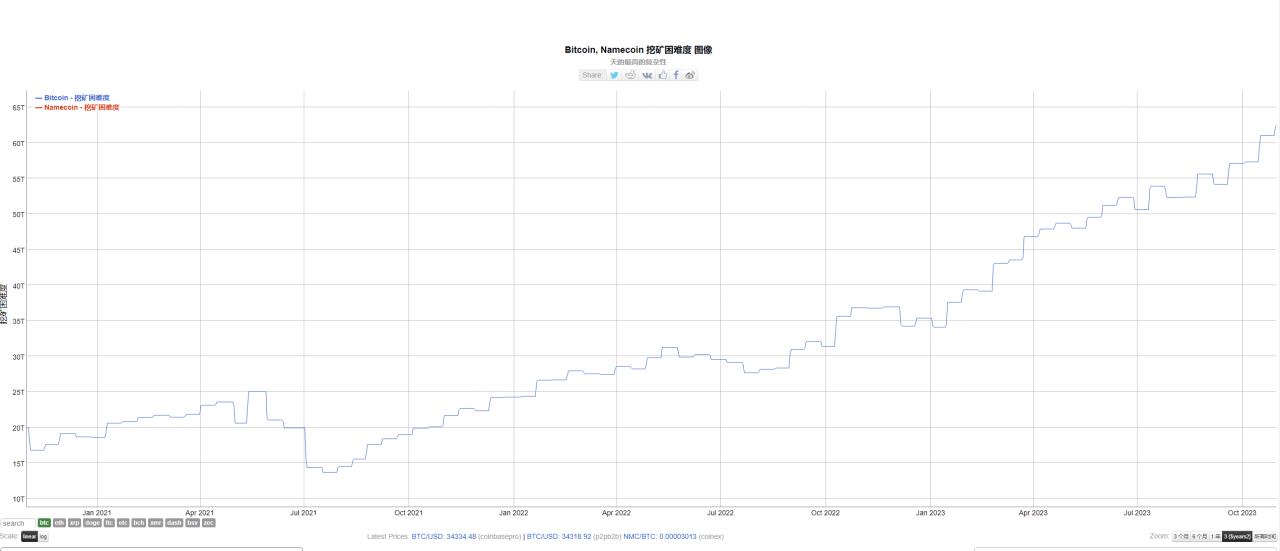
Meanwhile, the Bitcoin Layer 2 ecosystem continues to develop. As one of the Layer 2 networks of BTC, the projects and tokens within the Ordinals ecosystem are worth paying attention to amid BTC's dominant upward trend.
Ordinals(ORDI)
Ordinals Inscription
Ordinals (ORDI) is the leading coin in the BTC Layer 2 ecosystem and the creator of the Ordinals ecosystem.
The Ordinals protocol is a method for creating encrypted asset content on the Bitcoin blockchain, launched by Casey Rodarmor in January 2023. It allows data to be recorded on the smallest unit of Bitcoin, satoshi, and this data is called an inscription, similar to an NFT.
The act of creating inscriptions in the Bitcoin network is called "inscription," and the inscription itself is called "inscriptions."
BRC-20 Protocol
Based on the Ordinals Inscription, a unified protocol standard is established, written in JSON data format, and then written as an inscription on the Bitcoin network. This can be used to issue fungible tokens. This JSON-formatted inscription is the BRC-20 protocol, and the fungible tokens issued in this way are BRC-20 tokens.
The JSON can specify the total amount of tokens, as well as deployment, issuance, and transfer actions.
The first part, deploy, represents the deployment, indicating the issuance of a token named "ordi" with a total of 21 million.

The second part, mint, represents minting, with a maximum of 1,000 tokens minted each time.
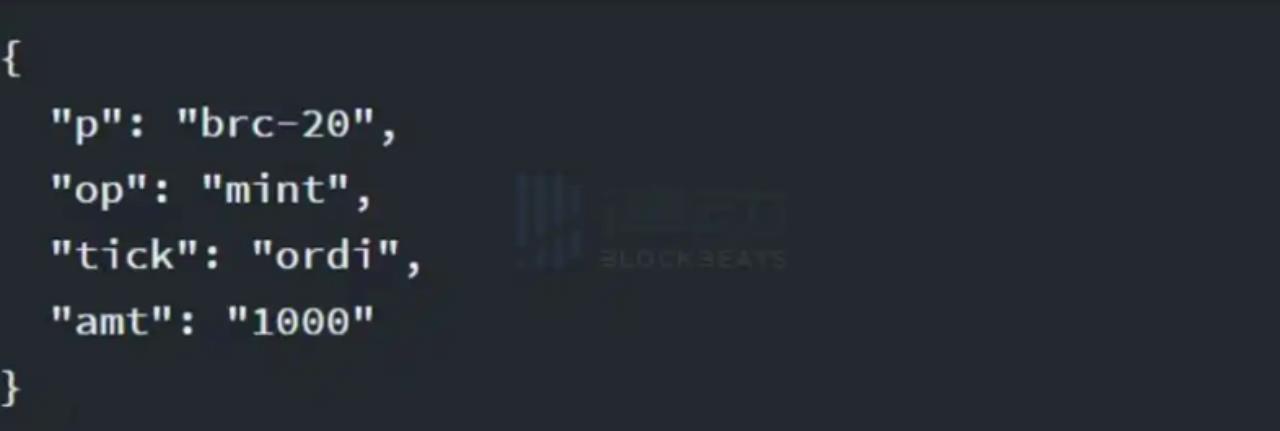
The third part, transfer, means transfer.

Ordinalswallet
In addition to the inscription protocol, Ordinals has also developed the native wallet, ordinalswallet. Similar to an Ethereum wallet, ordinalswallet is a non-custodial BTC wallet that allows users to view and store BTC and Ordinals NFT.
ORDI token Ordinals deployed the ORDI token on March 8, 2023, with a total of 21 million tokens. ORDI reached a peak price of $25. ORDI's total market value is $1.07 billion, ranking 260th among all cryptocurrencies.
Recently, as BTC has risen, ORDI, as the leader of the Ordinals ecosystem, has performed well, with a 47% increase in October.
Unisat
UniSat is a lightweight wallet based on the Bitcoin network that supports the Ordinals protocol and BRC-20 token standard. At the time of writing, UniSat Wallet has over 300,000 users.
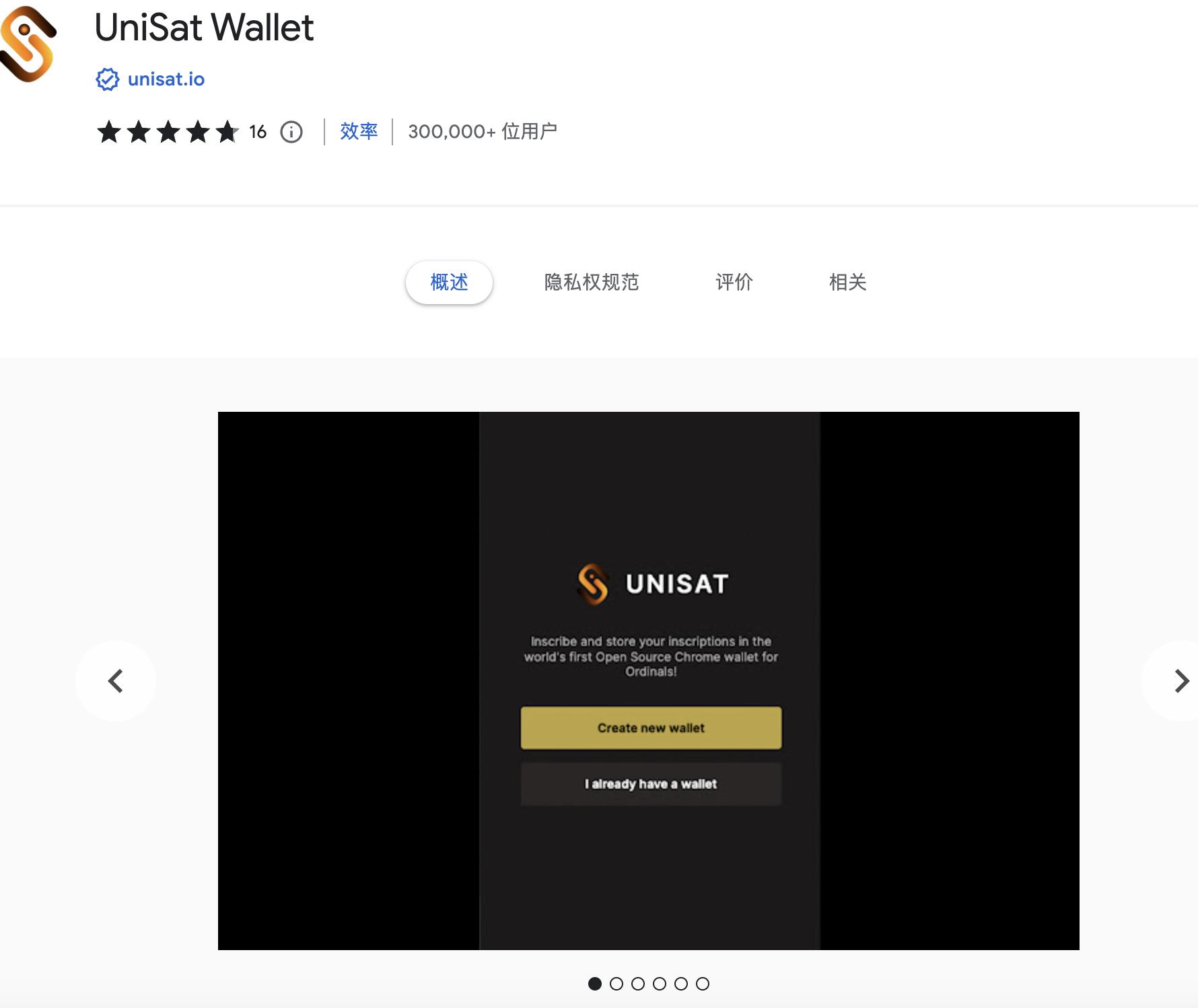
UniSat not only has a wallet product, but its main functions include:
- Supporting users to create, mint, and trade NFTs and tokens on the Bitcoin blockchain.
- Supporting the search for various information in the text content of inscriptions, including text.bitmpa.sats\unisat\brc-20\number\news.
- Displaying a complete list of BRC-20 tokens, including deployment time, holder data, and transaction quantity. Wallet BRC-20 balances can be queried based on addresses.
- Supporting the trading market for BRC-20 tokens and collectibles.
Ordiscan
Ordiscan is an ordinal block explorer that not only supports inscription, BRC-20 assets, and collectible data, but also offers API tools for developers. The Ordiscan API is currently in the testing phase.
Ordiscan shows a total of 35.714 million inscriptions, a total storage quantity of 13.4GB, and a total of 1318 BTC in mining fees generated.
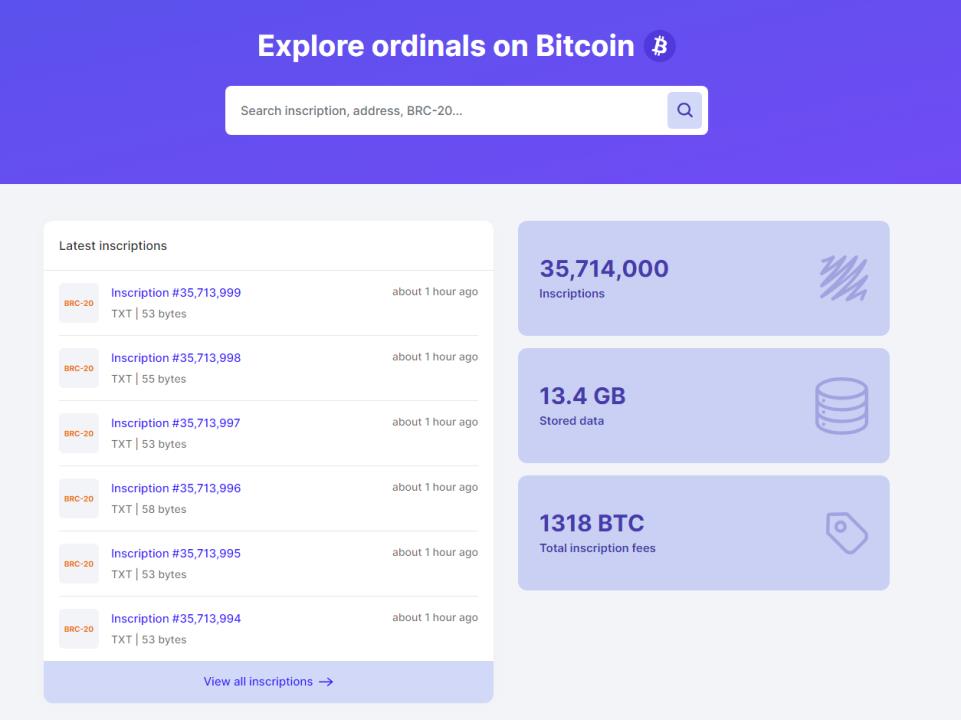
BRC-20 Tokens
Data from BRC-20.io shows that there are currently a total of 213 BRC-20 tokens, with a total market value close to $1.29 trillion. You can look at some popular BRC-20 tokens through the data.
SATS
SATS is currently the most sought-after and active BRC-20 token in the market, with over 36,000 holder addresses and over 21 million transactions, far exceeding other BRC-20 tokens.
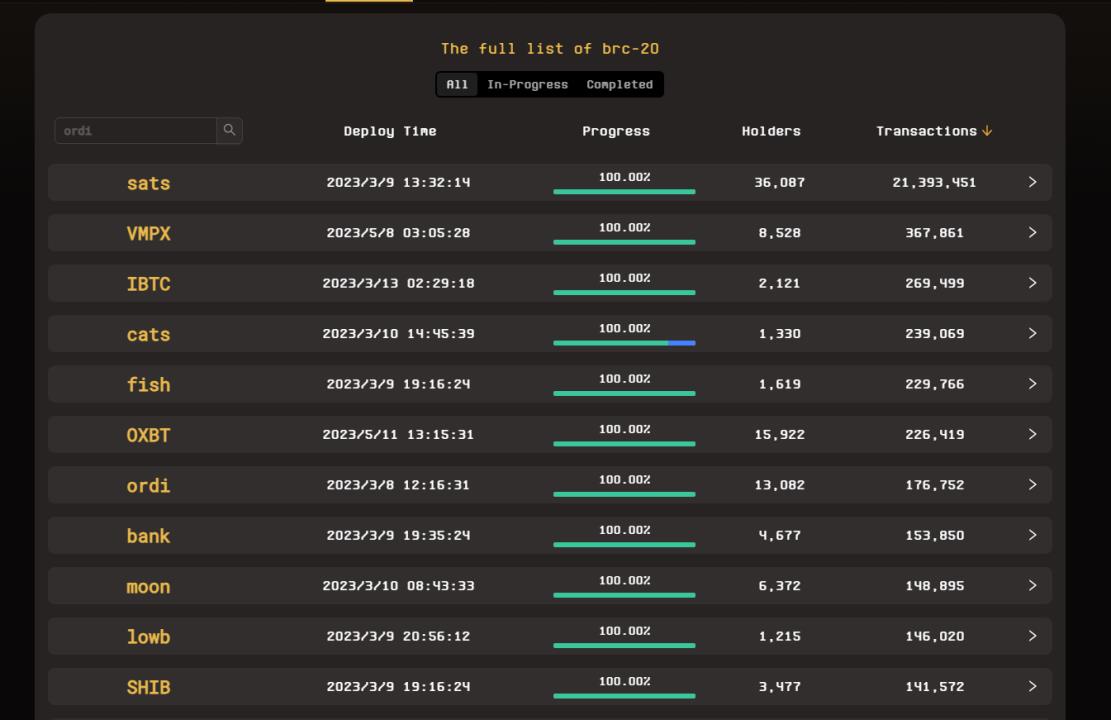
The total supply of SATS is 2,100,000,000,000,000, with a peak price exceeding $0.00000003 and a current price near $0.000000027, with a growth rate of 132% in October.
On September 28, Unisat released BRC20-Swap and explained the reason for using SATS as gas.

Poloniex, BingX, and Bibox3 have listed the SATS/USDT trading pair. SATS saw a 107% increase in October.
VMPX
VMPX's ecosystem activity is second only to SATS, but its transaction volume is much smaller than SATS, and it has relatively few holders.
The total supply of VMPX is 108,624,000, with a peak price exceeding $0.37 and a current price of $0.031. VMPX was popular in May to July 2023.
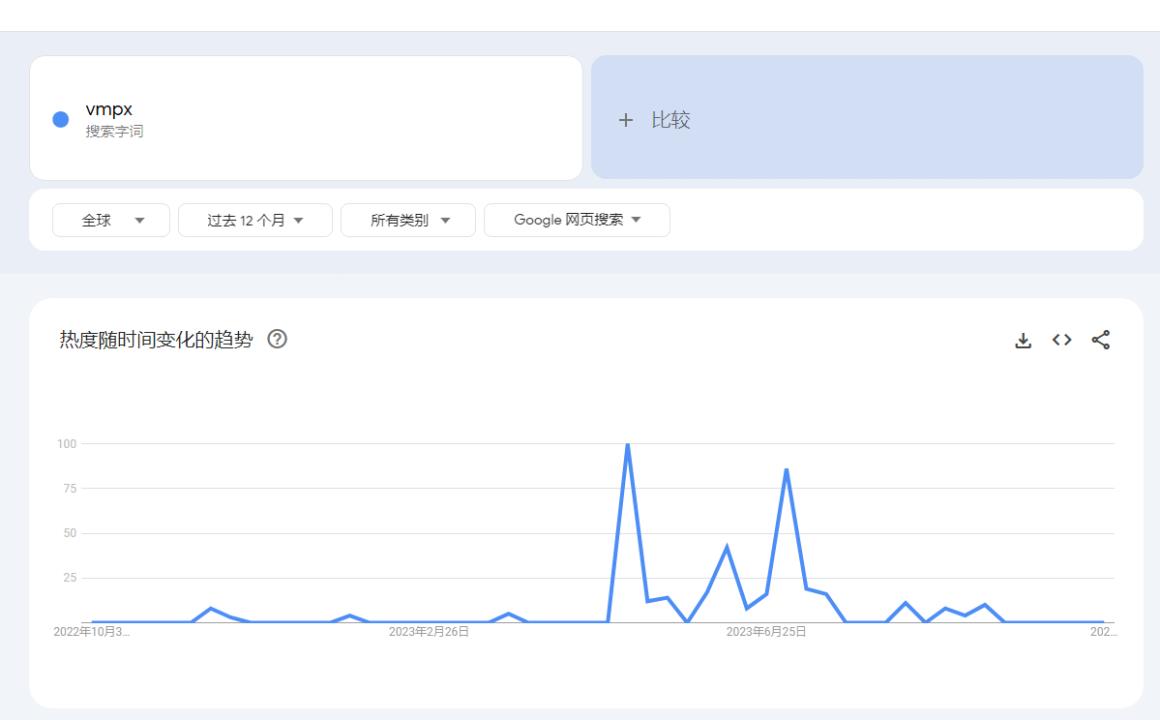
As an earlier BRC-20 token, VMPX has been listed on many CEXs, including Gate, Poloniex, Bitget, and MEXC, among 10 others. VMPX fell by nearly 30% in October.
OXBT
OXBT is also a relatively active BRC-20 token, ranking fourth in transaction volume and third in holders.
The total supply of OXBT is 200,000,000, with a peak price of about $0.26 and a current price near $0.012.
OXBT has been listed on two CEXs—AscendEX (formerly BitMax) and BitForex. OXBT fell by about 15% in October.
Controversy
Collectibles stored in the Bitcoin network through inscriptions have a stronger collectible value. However, there is currently some controversy about the significance and prospects of BRC-20. Those in favor of BRC20 believe that it has positive implications for the Bitcoin network and ecosystem.
Regarding the doubts about BRC-20, first, SlowMist Technology pointed out that there may be security risks from minting BRC-20 tokens to conducting transactions. During the token minting process, the security of the relevant BRC20 token minting platform is questionable, with relatively weak defense measures, making it susceptible to malicious attacks and code tampering, leading to asset theft during token minting. In terms of transaction methods, SlowMist Technology believes that both methods have security issues. One is to privately find a third party for trading, which easily encounters problems such as scammers and counterfeit coins; the other is to trade on dedicated trading platforms, but the security of these trading platforms cannot be guaranteed.
Second, the viewpoint represented by Haotian believes that BRC-20 violates the principle of decentralization. This is because BRC20 essentially stores transactions through inscriptions. For example, if I have 10 ORDI tokens and I transfer 10 ORDI tokens to Zhang San, I would write this action as an inscription. However, Li Si can also write an inscription claiming that I transferred 10 ORDI tokens to him. These two inscriptions conflict because I only have a total of 10 ORDI tokens. In this case, a centralized platform may be needed to determine which inscription is valid. If a small miner's fee is insufficient, it is likely to be squeezed out by a large holder with a higher miner's fee, introducing unfair factors.
On October 22, the NFT trading platform Magic Eden announced the suspension of BRC-20 trading due to the risk of double spending, as some users on the X platform reported recent order issues. Currently, different markets are using different versions of ord, indexing different inscription numbers. Before Magic Eden, OKX, and UniSat Wallet all use the same ordinal, there is a risk of double spending when trading BRC-20.
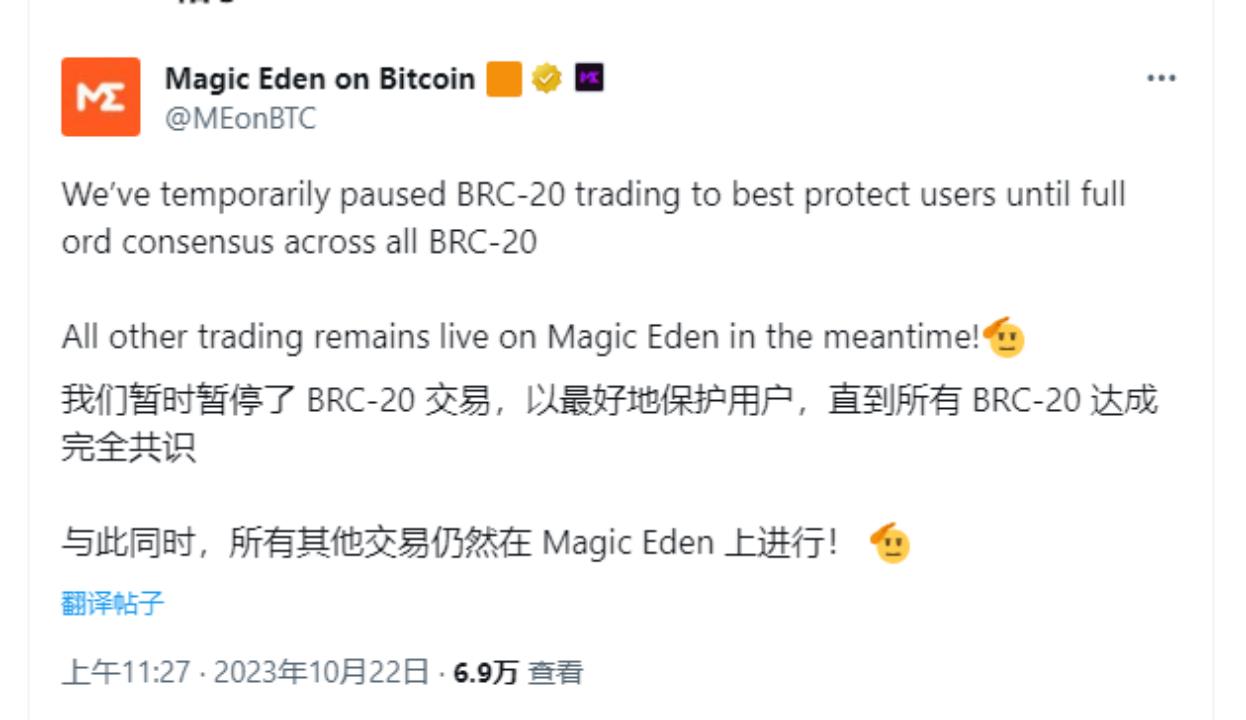
Ordinals Protocol Upgrade
On October 24, Ordinals creator Casey Rodarmor merged the v0.10.0 update into the Ordinals code. According to Block Rhythm's research, the important features of this update include: batch inscription, adding metadata, inscription number endpoint, and remote inscription command.
In batch inscriptions, multiple inscriptions can be placed in the same input at once, and the position of the inscription can be specified in the output. Adding metadata allows users to add meta-protocols to inscriptions, attach any type of information, and help indexers distinguish between different types of protocols. The inscription number endpoint allows visitors to retrieve inscriptions by number in the URL. The remote inscription command inscribes assets on the ordinal and sends the corresponding NFT to a remote inscription address for inscription.
BRC20-SWAP Testing
According to the official announcement from Unisat, BRC20-SWAP testing begins today. Currently, only whitelisted addresses can participate in the testing. The initial tokens for BRC20-SWAP are as follows:
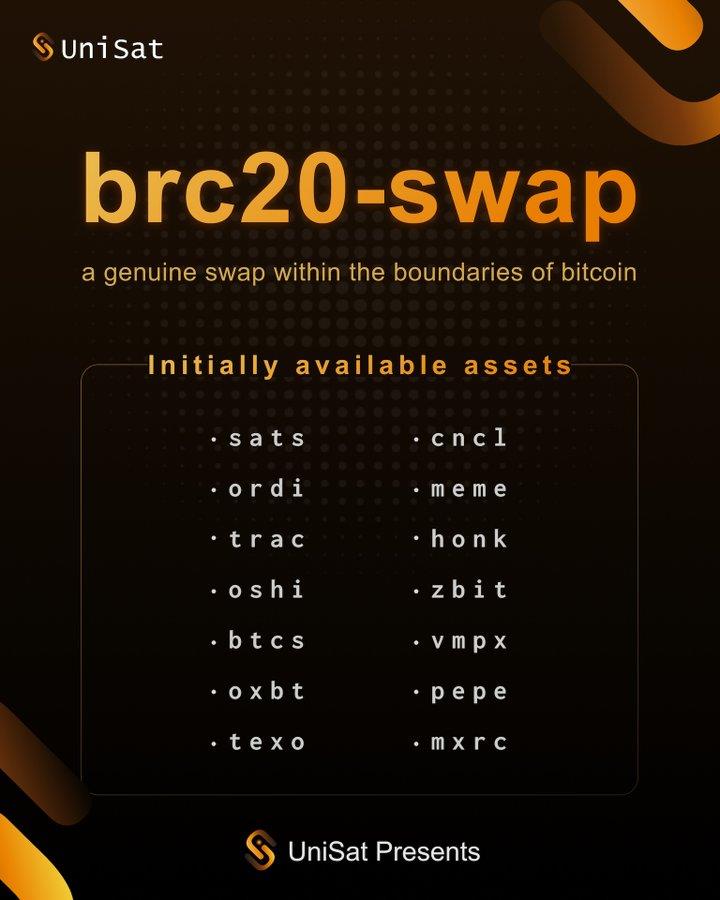
Summary
As a Layer 2 network ecosystem of BTC, the Ordinals ecosystem has not only successfully achieved the issuance of collectibles and fungible tokens within the Bitcoin ecosystem, giving them unique real-world value. More importantly, the issuance, circulation, and trading of these collectibles and fungible tokens further enhance the demand for BTC, providing more opportunities for BTC miners and benefiting the overall value of BTC.
However, most BRC20 tokens in the Ordinals ecosystem currently lack practical applications and comprehensive use cases. Among them:
ORDI, as the creator of the Ordinals protocol, has a certain real-world significance and market recognition.
SATS, as the trading GAS for Unisat's BRC20-SWAP, has a certain practical demand.
With the strengthening of global consensus on Bitcoin, the continued development of the Ordinals protocol, and the upcoming launch of BRC20-SWAP, the Ordinals ecosystem as a Layer 2 network of BTC may be worth continuous attention and observation.
免责声明:本文章仅代表作者个人观点,不代表本平台的立场和观点。本文章仅供信息分享,不构成对任何人的任何投资建议。用户与作者之间的任何争议,与本平台无关。如网页中刊载的文章或图片涉及侵权,请提供相关的权利证明和身份证明发送邮件到support@aicoin.com,本平台相关工作人员将会进行核查。




